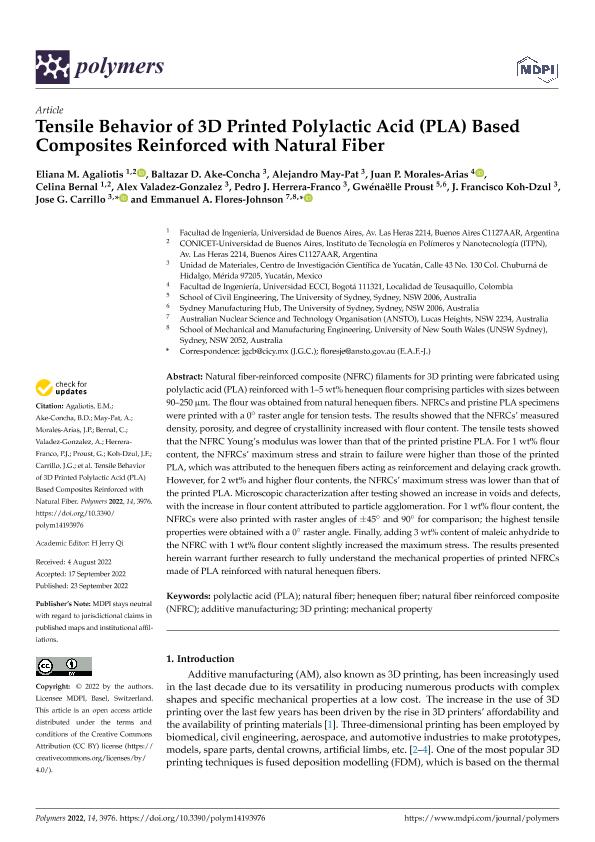Mostrar el registro sencillo del ítem
dc.contributor.author
Agaliotis, Eliana Mabel

dc.contributor.author
Ake-Concha, Baltazar D.
dc.contributor.author
May Pat, Alejandro
dc.contributor.author
Morales Arias, Juan P.
dc.contributor.author
Bernal, Celina Raquel

dc.contributor.author
Valadez Gonzalez, Alex
dc.contributor.author
Herrera Franco, Pedro J.
dc.contributor.author
Proust, Gwénaëlle
dc.contributor.author
Koh Dzul, J. Francisco
dc.contributor.author
Carrillo, Jose G.
dc.contributor.author
Flores Johnson, Emmanuel A.
dc.date.available
2023-10-10T16:00:42Z
dc.date.issued
2022-09
dc.identifier.citation
Agaliotis, Eliana Mabel; Ake-Concha, Baltazar D.; May Pat, Alejandro; Morales Arias, Juan P.; Bernal, Celina Raquel; et al.; Tensile Behavior of 3D Printed Polylactic Acid (PLA) Based Composites Reinforced with Natural Fiber; MDPI; Polymers; 14; 19; 9-2022; 1-17
dc.identifier.issn
2073-4360
dc.identifier.uri
http://hdl.handle.net/11336/214719
dc.description.abstract
Natural fiber-reinforced composite (NFRC) filaments for 3D printing were fabricated using polylactic acid (PLA) reinforced with 1–5 wt% henequen flour comprising particles with sizes between 90–250 μm. The flour was obtained from natural henequen fibers. NFRCs and pristine PLA specimens were printed with a 0° raster angle for tension tests. The results showed that the NFRCs’ measured density, porosity, and degree of crystallinity increased with flour content. The tensile tests showed that the NFRC Young’s modulus was lower than that of the printed pristine PLA. For 1 wt% flour content, the NFRCs’ maximum stress and strain to failure were higher than those of the printed PLA, which was attributed to the henequen fibers acting as reinforcement and delaying crack growth. However, for 2 wt% and higher flour contents, the NFRCs’ maximum stress was lower than that of the printed PLA. Microscopic characterization after testing showed an increase in voids and defects, with the increase in flour content attributed to particle agglomeration. For 1 wt% flour content, the NFRCs were also printed with raster angles of ±45° and 90° for comparison; the highest tensile properties were obtained with a 0° raster angle. Finally, adding 3 wt% content of maleic anhydride to the NFRC with 1 wt% flour content slightly increased the maximum stress. The results presented herein warrant further research to fully understand the mechanical properties of printed NFRCs made of PLA reinforced with natural henequen fibers.
dc.format
application/pdf
dc.language.iso
eng
dc.publisher
MDPI
dc.rights
info:eu-repo/semantics/openAccess
dc.rights.uri
https://creativecommons.org/licenses/by/2.5/ar/
dc.subject
3D PRINTING
dc.subject
ADDITIVE MANUFACTURING
dc.subject
HENEQUEN FIBER
dc.subject
MECHANICAL PROPERTY
dc.subject
NATURAL FIBER
dc.subject
NATURAL FIBER REINFORCED COMPOSITE (NFRC)
dc.subject
POLYLACTIC ACID (PLA)
dc.subject.classification
Compuestos

dc.subject.classification
Ingeniería de los Materiales

dc.subject.classification
INGENIERÍAS Y TECNOLOGÍAS

dc.title
Tensile Behavior of 3D Printed Polylactic Acid (PLA) Based Composites Reinforced with Natural Fiber
dc.type
info:eu-repo/semantics/article
dc.type
info:ar-repo/semantics/artículo
dc.type
info:eu-repo/semantics/publishedVersion
dc.date.updated
2023-07-07T22:56:43Z
dc.journal.volume
14
dc.journal.number
19
dc.journal.pagination
1-17
dc.journal.pais
Suiza

dc.journal.ciudad
Basel
dc.description.fil
Fil: Agaliotis, Eliana Mabel. Consejo Nacional de Investigaciones Científicas y Técnicas. Oficina de Coordinación Administrativa Houssay. Instituto de Tecnología en Polímeros y Nanotecnología. Universidad de Buenos Aires. Facultad de Ingeniería. Instituto de Tecnología en Polímeros y Nanotecnología; Argentina
dc.description.fil
Fil: Ake-Concha, Baltazar D.. CENTRO DE INVESTIGACION CIENTIFICA DE YUCATAN (CICY);
dc.description.fil
Fil: May Pat, Alejandro. CENTRO DE INVESTIGACION CIENTIFICA DE YUCATAN (CICY);
dc.description.fil
Fil: Morales Arias, Juan P.. No especifíca;
dc.description.fil
Fil: Bernal, Celina Raquel. Consejo Nacional de Investigaciones Científicas y Técnicas. Oficina de Coordinación Administrativa Houssay. Instituto de Tecnología en Polímeros y Nanotecnología. Universidad de Buenos Aires. Facultad de Ingeniería. Instituto de Tecnología en Polímeros y Nanotecnología; Argentina
dc.description.fil
Fil: Valadez Gonzalez, Alex. CENTRO DE INVESTIGACION CIENTIFICA DE YUCATAN (CICY);
dc.description.fil
Fil: Herrera Franco, Pedro J.. CENTRO DE INVESTIGACION CIENTIFICA DE YUCATAN (CICY);
dc.description.fil
Fil: Proust, Gwénaëlle. University of Sydney; Australia
dc.description.fil
Fil: Koh Dzul, J. Francisco. CENTRO DE INVESTIGACION CIENTIFICA DE YUCATAN (CICY);
dc.description.fil
Fil: Carrillo, Jose G.. CENTRO DE INVESTIGACION CIENTIFICA DE YUCATAN (CICY);
dc.description.fil
Fil: Flores Johnson, Emmanuel A.. University of New South Wales; Australia
dc.journal.title
Polymers
dc.relation.alternativeid
info:eu-repo/semantics/altIdentifier/url/https://www.mdpi.com/2073-4360/14/19/3976
dc.relation.alternativeid
info:eu-repo/semantics/altIdentifier/doi/http://dx.doi.org/10.3390/polym14193976
Archivos asociados
